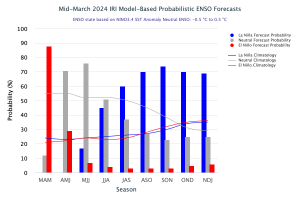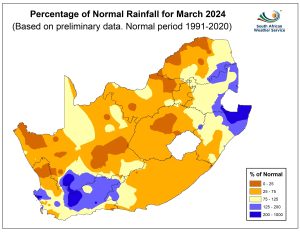Based on oceanic and atmospheric conditions in the central-eastern Pacific Ocean, an El Niño advisory remains. According to the mid-March model assessments by the International Research Institute for Climate and Society, the El Niño Southern Oscillation (ENSO) signal remains in an El Niño state for the March-April-May (MAM) period. There is a high likelihood for neutral conditions to develop in autumn, while the long-term assessments suggest a potential return of a La Niña cycle later in the year.
The ongoing El Niño event has reached its peak and is currently diminishing. However, its effects are currently being experienced in various parts of the world. For example, South Africa’s neighboring countries, i.e. Malawi, Zambia and Zimbabwe are currently experiencing an El Niño-induced drought and have each declared a state of national disaster due to its impacts on livelihood, e.g. electricity supply (hydro-power). Therefore, it is essential for South Africa to remain alert as an El Niño advisory remains.
Figure 1: Mid-March ENSO Forecast by IRI.

Similar to February 2024, most of South Africa, as well as uMngeni-uThukela Water’s area of operation, received below-average rainfall during March 2024. However, most dams managed by uMngeni-uThukela Water remained in relatively high storage levels, with the levels of major dams such as Midmar, Albert Falls, Inanda and Goedertrouw Dams currently at 96%, 100%, 101% and 99% of full supply capacity, respectively.
Figure 2: March 2024 rainfall as a percentage of the long-term average (Source: South African Weather Service)

Although relatively below-average rainfall was received during March 2024, there is no risk of non-supply to UUW’s customers in the short term. However, prolonged periods of below-average rainfall (as suggested by the South African Weather Service) may increase the risk of non-supply through low storage levels. Furthermore, developments from SA’s neighbouring countries (i.e. Zambia, Zimbabwe and Malawi) warrant the need to remain alert and closely monitor climatic conditions and dam levels.
Table 1: A three month comparison of water levels as % of full supply capacity in UUW and some DWS-managed dams.
| Site Name | Dam Level (% of full supply capacity) | ||
| 01 February 2024 | 01 March 2024 | 01 April 2024 | |
| Mearns Dam | 106 | 103 | 108 |
| Spring Grove Dam | 95 | 99 | 101 |
| Midmar Dam | 100 | 100 | 96 |
| Henley Dam | 105 | 107 | 105 |
| Albert Falls Dam | 101 | 101 | 100 |
| Nagle Dam | 101 | 100 | 86 |
| Inanda Dam | 102 | 102 | 101 |
| Home Farm Dam | 104 | 103 | 101 |
| Nungwane Dam | 102 | 101 | 101 |
| Umzinto Dam | 100 | 100 | 100 |
| E.J. Smith Dam | 100 | 100 | 100 |
| Mhlabatshane Dam | 101 | 101 | 101 |
| Ludeke Dam | 68 | 46 | 49 |
| Hazelmere Dam | 83 | 83 | 84 |
| iMvutshane Dam | 87 | 60 | 56 |
| Goedertrouw Dam | 100 | 99 | 99 |
| Pongolapoort Dam | 81 | 81 | 84 |
| Olifantskop Dam | 106 | 104 | 106 |
| Spioenkop Dam | 101 | 100 | 100 |
| Wagendrift Dam | 101 | 101 | 101 |
| Woodstock Dam | 91 | 96 | 100 |
uMngeni-uThukela Water (UUW) encourages its customers, and water users in general, to practice and promote water resources conservation measures. UUW publishes home-based water conservation tips on a weekly basis through the company’s social media platforms and encourages the public to share more tips that promote water use efficiency at household level. uMngeni-uThukela Water will issue an update at the end of April 2024.